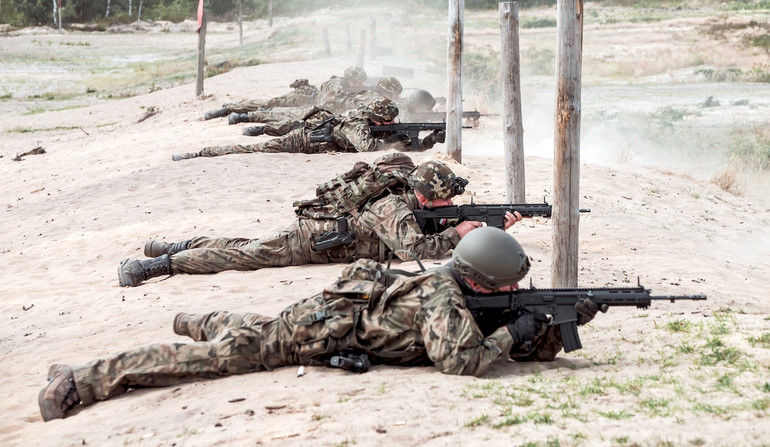MSBS Grot Rifle. A New Generation of Polish Weapons [Analysis]
Signing of an agreement concerning the deliveries of the MSBS “Grot” rifles, during the MSPO 2017 exhibition, is a major step made towards introduction of this domestically designed modern weapon into use. It is to replace the Beryl assault rifles. Beryl (beryllium) is actually a modification of Kalashnikov system rifles that have been manufactured in Poland for more than 60 years now. The contract to acquire the Grot rifles has been discussed by the commander of the Territorial Defence component of the Polish Armed Forces, Brig. general Wiesław Kukuła and Adam Sulliga, President of the Radom-based FB Radom firearms factory.
Conclusion of the agreement concerning the delivery of more than 53 thousand examples of the Grot C 16 FB-M1 rifles belonging to the MSBS-556 family, that took place during the 25th edition of the Kielce MSPO event, has been announced to be the most important contract signed during the exhibition. The agreement, valued at 500 million zlotys, has been signed between the Polish JWK NIL military unit and the Radom-based Fabryka Broni.
The opinionmakers were doubtful with regards to the circumstances in which the contract was signed, including the media reports suggesting that the state test programme has not been finalized. Thus it is worth to clarify the circumstances and goals of signing the agreement, as well as the procedure adopted to conclude it.
- “At the stage when the procurement was being designed, it was a dogma for us to assume that there would be a need to continuously perfect the weapon, similarly as it is done by Armed Forces of other countries. Thus, the rifle name is going to feature an “M” suffix. In this way, the first batch of the weapons procured is to bear the designation of GROT 16C FB-M1, but at the moment we have assumed that within the framework of the agreement implemented it would be possible to modify the weapon even up to the M3 standard. What information is included in the designation? 16 refers to the barrel length, in inches, C refers to classic (conventional) rifle layout, while M and the number refer to the modification designation. Today we also expect that a situation would emerge in which a need may arise to upgrade the rifle from M1, up to M3 standard, for example. We are creating a system, within which conditions that are inspiring the manufacturer to continuously perfect the weapon, in line with the requests submitted by the soldier” - as we were told by General Wiesław Kukuła, Commander of the Territorial Defence component of the Polish Armed Forces.
Not only was the operational experience-based modernization of the weapon planned, as it is also expected that the old models are modernized to match the latest standard. This is quite frequent procedure, already utilized in Poland e.g. in case of the wz. 96 Beryl weaponry that, during the overhauls, was modernized e.g. through addition of the Picatinny rails. In case of the Western designs, such as the modular FN SCAR rifle, or Minimi LMG, the weapons also feature more and more modifications implemented as a result of findings concerning the potential problems emerging during the operational use.
Sometimes, such conclusions lead towards significant design changes, which has been proven e.g. by the Czech BREN rifle. CZ805 that was not very successful, that was bulky and its design was not very good ergonomically, and that was very heavy (4 kilograms) was successfully upgraded to the CZ806 standard which, at the moment, has become one of the demanded Czech export products acquired by a French special forces unit, with India and Pakistan considering acquisition of manufacturing licenses to produce hundreds of thousands examples locally.
Also, the legendary M16 rifle, in its original variant, has turned out to be unreliable and demanding when it came to maintenance, which led towards creation of further modifications.
Grot begins its career as a weapon that is much more mature, already modified with regards to its form. Nonetheless it should be expected that intensive operational use of 1000, and more large batches of the weapon, would expose a need to optimize its design. Within that scope, a need would emerge to make an agreement between the manufacturer and the user. The agreement is a long-term document, thus there would be enough time to work on the relevant changes. The manufacturer - Radom-based Fabryka Broni company - assures that jointly with the Territorial Defence component it is going to analyze the remarks and actively cooperate in introduction of those.
What was signed by Fabryka Broni [Łucznik Radom facility] and is the factory going to be able to face the challenge?
When it comes to the agreement signed on 5th September, numerous doubts emerge. One of those doubts refers to the value and profile of the contract. It is a 4-years long contract, within which, in 2017, delivery of the first thousand out of 53 thousand contracted Grot rifles has been planned. During the upcoming years the deliveries will be much more intense, which evokes doubts among the experts, with regards to the production capacity. Especially in a situation in which, starting from August this year, the Fabryka Broni facility announced that it plans to invest 90 million zlotys in a modern manufacturing line, where an amount of 81 million is a part of a loan provided by BGK.
READ MORE: FB Radom Facility: Loan-Financing of Modernization
As Adam Suliga, President of the Management Board at the FB Radom facility, assures - By signing the agreement and planning the quantities, we took the manufacturing capacity into consideration, along with the fact that machinery is going to be replaced -.In August this year the facility has finalized the manufacturing of the wz. 96C Beryl rifles that had been contracted earlier for the current year. Now, the free capacity may also be used to manufacture the Grot rifle. In parallel, procurement and set up of modern CNC machining equipment is being carried out which allow for more intensive manufacturing process to take place.
Referring to manufacturing speed and cost, price issue shall also be mentioned. Not only in case of this contract, but quite often, an intention to divide the value simply by the number of examples emerges. In this specific case this is especially difficult, as the exact number of the rifles has not been published, same applies to the exact amount defining the contract - generally referred to as half billion zlotys. As Suliga stresses, the value applies both to 53 thousand rifles, as well as to creation of infrastructure related to training and support for operational use of a new weapon in the Army - the Grot rifle.
The training system, with the e-learning package, has been an element emphasized by the command of the WOT [Territorial Defence] component of the Army. The option of providing digital education with regards to weapon’s design or safety of operation saves time in a short training cycle remaining at disposal of the WOT soldiers.
Not only does the kit that comes with the Grot rifle differ in the e-learning tutorial, it also includes many more extra magazines which increases the cost but is related to the specific nature of operations. The cost concerning the procurement of extra magazines is lower with the weapon, in comparison with a potential separate delivery.
The rifle will be bought in a specific variant, e.g. along with 8 magazines. This is embedded within our conclusions and postulates related to the component profile and to the requirements of the modern battlefield [...] With a great degree of satisfaction I can notice how far the perceiving of the Polish defence industry has changed, as it understands the soldiers’ requirements better and better, as not only was equipment tailored to the new rifle, but also accommodating more magazines presented in Kielce, during the MSPO Salon. Here, the Dromader kit, as well as other offers, may be seen as a good example.
Tests and Agreements. What shall come first?
The MoD’s release concerning the concluded contract includes information suggesting that the qualification tests programme has not yet been finalized. The media suggest that the said programme would end in the first quarter of 2018. The deliveries of this year’s batch of 1000 examples of the Grot weaponry have been meanwhile planned to happen in November and December.
The weapon that is going to be included in the inventory kit of the military shall pass the qualification test programme. How one can make agreement in this context, seemingly full of conflict? The aforesaid deadline for finalization of the tests has been derived from the schedule related to the Tytan programme, according to which the rifles were to be received by the Army after 2021. This year MSBS has been excluded from the programme, and the system has a new administrator - the WOT component. Thus the test programme has undergone modifications, it is to be finalized in October 2017, a month before the deliveries begin.
Not only does the commission overseeing the test programme include the representatives of the Territorial Defence forces, but also other branches of the military, the Armament Inspectorate of the Polish Ministry of Defence, Support Inspectorate of the Polish Armed Forces and other institutions are also deeply involved in the process. According to the information we have obtained, at the moment the weapon’s wear tests are being conducted. For obvious reasons, this stage remains highly time-consuming. At the earlier stages of the test programme MSBS had been passing such tests positively, several times.
The weapon, for at least a decade one, has been passing a variety of tests with positive results, thus General Kukuła was recommending that the contract shall be signed during the 25th edition of the MSPO defence expo in Poland.
Some doubts have also emerged with regards to the conclusion of the contract with the Fabryka Broni, not by the Armament Inspectorate, but by the Nil unit of the Polish Army which, even though it frequently deals with procurement, this procurement is usually carried out for the Special Operations Forces. The unit in question, nonetheless, also manages acquisitions for other branches of the military.
Nil unit has been acting as an intermediary party, e.g. in case of procurement of the Antos mortars for the air-mobile units of the Polish Armed Forces. In case of acquisition of the Grot rifles, the WOT component has been using the assistance provided by the Nil unit, as neither WOT has a proper organ embedded within its structure to deal with such procedure, nor is it experienced in such negotiation processes. On the basis of Decision No. 92/MON issued by the Minister of Defence, on 28th April 2017, with regards to the procurement of the WOT equipment, the commander may be a direct administrator, without any support provided by the intermediary activities performed by the Armament Inspectorate.
Cooperation between the Territorial Defence forces and the Special Operations component also cannot be disregarded. JW Nil needed more than a month to prepare a contract and negotiate the conditions with the Radom-based facility. The unofficial information obtained by us suggest that this is not the last of the agreements that is going to be implemented with assistance provided by the aforesaid unit. The logistics support organ in the WOT component is being established now.
Conclusions Gathered During the MSBS Rifles Test Programme
Some confusion in communications could also have been introduced by the information on the introductory operational tests carried out by a variety of branches of the Polish military, including WOT and Special Operations components. It shall be noted that these procedures shall be viewed separately from the qualification test programmes, as their results are not binding, while the whole process is based upon agreements concluded with the manufacturer. The goal would be to verify the experience of the soldiers, gathered in intense, operational conditions.
The aforesaid 92/MON decision issued by the Defence Minister on 28th April 2017, concerning the acquisition of military equipment for the Territorial Defence units, allows the commander to test the armament - this possibility has been used in case of the MSBS rifle system. The weapon is being tested by other military units too, however it is a specific nature of WOT that it includes soldiers without prior training, which allows for verification of differences between the units (effectiveness) using the wz. 96 Beryl rifles and the MSBS Grot weapon.
Such result shall not be surprising, as 50 years is the period that divides the weapons design-wise. It shall be recalled that wz. 96 Beryl is a modified Kalashnikov model, and this system of weaponry has been manufactured at the Radom facility since 1950s.
The general layout of the rifle, ergonomics and the principle of operation have remained largely unchanged. The changes concerned, primarily, application of standard 5.56 ammunition (even though the rifle is derived from the wz. 88 Tantal weapon, shooting a similar 5.45 mm round) and featuring elements such as mounting rails or stock.

Meanwhile, MSBS Grot system is a modern weapon developed from scratch during the recent decade, based upon designs such as the modular Lantan rifle. The solutions implemented in MSBS design are legally protected by six patents, six Community industrial designs and one industrial design.
The test programme did not expose any significant defects, they have rather exemplified the habits of the users. For the soldiers who have been using the Beryl rifle the sight has been new - with a hole in the rear sight, applied instead of a conventional rear sight.
The Special Forces, frequently utilizing the HK416 system, complain about the hard trigger, as the commando weaponry usually features lighter sporting-like trigger mechanisms. Another concern is the 45-degree angle step of the fire selector (commando weaponry has a step of 90 degrees which causes the users to switch the weapon to full-auto mode, instead of single shot mode). One of the elements criticized by most of the users is the stock, which requires further work.
We are trying hard to inspire the Polish manufacturers to create a kind of ecosystem around the GROT rifle, with extra equipment packages for this weapon – as we were told by General Wiesław Kukuła, stressing the fact that the rifle should be fitted with a wide assortment of domestically manufactured equipment. Thus, during this year’s edition of the MSPO event, Szafir sight has been awarded by the WOT Commander. It is to be the primary sight type for this component.
MSBS may also be used with components other than the ones manufactured domestically. It is the first Polish carbine fully compliant with the NATO standards. Not only does it feature Picatinny rails that may be freely reconfigured, it may also be fed from standard STANAG magazines, such as the ones coming from the German HK416, British SA80 or Czech Bren 2 or the US M4 weapons. During the tests in the Territorial Defence component, the weapon was verified with several magazines delivered by a variety of manufacturers.
The tests have shown that Grot is less susceptible to jamming when using low quality ammo or when shooting from a dirty barrel in intense battle, or when it is insufficiently maintained, also when compared to the weapons used by the Special Forces now.
Who is to receive the Grot rifles?
The question as to who is going to receive the 53 thousand Grot rifles is quite tough. Contrary to what it may seem, the number is not tied to the 50 thousand of WOT soldiers. This is directly derived from a structure of a light infantry squad which is the basic organizational unit in this formation. According to the composition disclosed back in 2016, 1/4 of the squad is not going to use the MSBS-556 variant (two sharpshooters using the .308 Win rifles and one LMG operator).
Grot rifles are, hence, going to be received also by the operational units of the Armed Forces. At the moment no official data as to what units would receive the rifles exists. Due to the fact that the rifles are fully compliant with the STANAG norms, MSBS Grot would be a natural choice for the soldiers deployed abroad and for those who cooperate with the NATO units in Poland. The same arguments apply to possible introduction of the rifle to the units operating together with the WOT component, for the sake of unification.
Ultimately, it is planned that 5.56 mm calibre is employed in the military, with the 7.62x39 mm round weaponry being decommissioned. This type of weapons is to be replaced by Beryls, to be replaced, in the frontline units, by the Grot rifles. Such solution would allow for a fluid transition to a unified standard, with proper reserves and affordable cost levels maintained.


![Soldiers trained with the MSBS system attain results that are 20% better, in comparison to those trained with the Beryl rifle. Image Credit: WOT [Territorial Defence Forces]](https://cdn.defence24.pl/2017/12/01/580xpx/Qf87Xna8By2CB4rACzlpNVXX8rIDH5TEGUAgpqTz.wcpr.jpg)
![Image Credit: WOT [Territorial Defence Forces]](https://cdn.defence24.pl/2017/12/01/580xpx/7S47Fs3GH1ctJAZnRWTm8eqw3OErmPUcUbu287nd.ze78.jpg)


